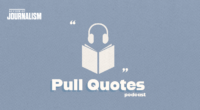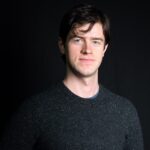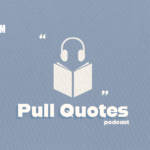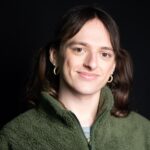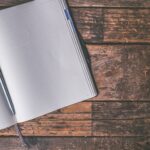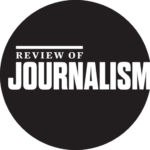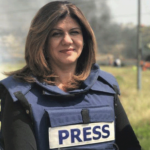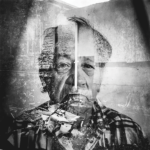[Intro music plays]
Silas Le Blanc: Photojournalism is an essential part of the media’s mandate to inform the public. Photojournalists work at the local level, covering important daily events, but also have assignments that take them to far flung places to document major world events. This puts them, often, in the thick of the action, searching for the frames that they hope will accurately portray what they are witnessing.
Tara De Boer: But especially when it comes to covering tragedy, destruction and death. It’s a slippery slope for those behind the camera as questions of ethics, morality, and exploitation come under the scanner. These issues are explored in Iman Adem’s Review of Journalism story “Behind the Frame.” And as the name suggests, it’s a story which focuses on the ethics of photojournalism. When I was reading Iman’s article, I was struck by two issues raised by one of the photojournalists in the piece, Andrew Jackson, a Montreal-based photographer, who’s also on the advisory panel of the photo ethics centre.
SL: First, he’s quoted in a month piece asking, “why is it that you’re able to show dead black people and dead brown people in graphic ways and images and in newspapers in the Global North, but white people aren’t photographed and shown in the same way in the Global North? And we have to ask ourselves, why does that happen? And perhaps in one sense, this maintains the status quo of civilized and uncivilized.”
TD: I found this to be compelling as it leads me to think more critically on how I myself consume photojournalism. Hearing these concerns from Jackson reveals the depth and nuance of the profession, and how impactful a photo can be on the event it’s documenting itself. And then there was just one comment he made that impinges upon the conscience or mindset of the photojournalist.
SL: He tells Iman “as photojournalists, you travel around the world, photographing chaos, death, and destruction. It doesn’t matter whether this is a dead child in Haiti, or a dead child somewhere in Africa, or Southeast Asia or whatever. It’s just the composition. That is a dangerous thing if we just see people in crisis as compositions.” Jackson isn’t the only voice and Iman’s comprehensive photo essay-style piece, which illustrates the photojournalist perspective with images of the work they do to counterbalance the concerns they raise. Today, Iman sits down with Tara to discuss what drew her to the thesis of the story, and how she found a way to tell it.
TD: Welcome to the final episode of the sixth season of Pull Quotes. We’re your hosts Tara DeBoer, Silas Le Blanc and Tim Cooke.
TD: Hi Iman, thank you so much for being with us on Pull Quotes today, how are you doing?
Iman Adem: Good. Thank you for having me. How are you?
TD: I’m doing good, thank you. Of course. So, I really enjoyed your story. And I wanted to ask you, what drew you to this particular area of journalism for this year’s Review of Journalism magazine?
IA: Basically, towards the end of 2020, when the BLM protest hypes died down, there was this discussion about people being desensitized to Black and Brown death because of the police brutality videos that were circulating in the media a lot during that time. So that conversation was definitely in the back of my mind. But getting to this story in particular, there was a photo essay done for the New York Times that I mentioned in my story called “Stepping over the Dead in a Migrant Boat.” And it was a collection of images, with boats full of migrants from Eritrea, Somalia and Ethiopia, all countries very close to me. And the narrative could have easily been, you know, highlighting the plight of migrants, but instead, showed these images of survivors stepping over dead bodies, like the title was saying. You know, you saw images of men and women visibly in, you know, a state of panic and when in one of the worst situations imaginable. And then these photos coupled with the headline stepping over the dead, and commentary from a journalist, a photojournalist, who described the photos as feeling as though you’re not living in a civilized world, it just… the entire thing was very dehumanizing. And to me the narrative was almost set up, like “look at these uncivilized Africans doing whatever it takes to get to the West.” So yeah, so the narrative that was coming through these photos, you know, be it intentionally or unintentionally, I didn’t like. It was very dehumanizing. It didn’t highlight that these were real individuals who were actually leaving a life behind by getting on these migrant boats, they had a lot to lose by getting on these boats…
[News clip of migrant being interviewed]
IA: …and the images weren’t doing what I assumed they intended to do, so they really inspired me to take a more critical look at shock value photojournalism.
TD: Wow, yeah, it sounds like it really struck a nerve in you. And I think that’s when the best stories are produced, when it sounds like it’s it was quite personal for you and you felt like this needed to be told. You chose to centre your story around three photojournalist Andrew Jackson, Sebastián Hidalgo and Daniella Zalcman. So, I’m wondering how you selected these photographers as these big voices in your stories.
IA: I had the opportunity to interview a few journalists with the three that you mentioned that were in my story. Each kind of had a special approach to their work. So, Daniella Zalcman. She covers Indigenous communities. She has this ongoing project called Signs of Your Identity, where she takes portraits of residential school survivors, superimposes them with images of the sites of the residential schools that they went to, or just their past and then coupled with a commentary about their time there. So, Daniella’s work really spoke to me because it doesn’t shy away from the trauma that comes with coming from a residential school. But also, it’s very humanizing. And it highlights these are real people with real experiences. I found Andrew Jackson when I was watching a panel on photojournalism. And he was one of the speakers on the panel. The images in the story, in my story, that Andrew Jackson took are from a collection of photos called From a Small Island, which is also a photo essay, I guess, about migration, it’s about Caribbean migration to the U.K.
[clip of Jackson talking about his work]
…the issue, or the, kind of, the story surrounding migration is always seen as, as a problematic thing. It’s always seen as facts and figures and numbers. And what I wanted to do with this work was to look at in terms of a human experience, that’s a story.
[clip fades out]
IA: But unlike the New York Times story that I just mentioned, it highlights images, where they came from…
[Clip of Jackson continues]
I was intrigued by what their lives could have been if they had chosen different paths, but also what Jamaica would have been. And I was convinced that I needed to go to Jamaica to continue this work.
[clip fades out]
IA: It’s a more–in my opinion–a more thoughtful approach to telling stories like that. And then Sebastián Hidalgo. He writes a lot about trauma-informed journalism. He captures his community very heavily, and he– a lot of violence in his community, as well as school shootings. But his approach is very thoughtful, he spends a lot of time in these communities. And he goes back to the communities even after the photos are taken. And so that’s why I kind of chose to highlight these three photographers.
TD: It sounds like they all are very intentional about the focus of their work. So I’m curious, based on your conversations with each of them, what would you say, drives these photographers and how they tell stories?
IA: I don’t know if I could say… I mean, that clearly, they’re all very passionate about photojournalism. I don’t know if I could speak for them and say that what drives them, but I know that they all–I mean, two of them at least–had moments in their career where they had to kind of reflect on a photo that was taken and ask themselves why they took that photo. I think a common theme in the three photographers that I interviewed was that they really centred care. Care was really important to them. They really gave themselves time to go to these communities and engage with their communities as best they could.
TD: Okay, so just to switch gears a little bit. I’m curious, based on your learning throughout this process of reporting, do publishers still pressure photojournalists to produce work that maybe doesn’t adhere to their own ethical standards? Did you get any of that out of your discussions with these photojournalists?
IA: Well, there’s no way to tell what each individual’s ethical standards are. So, that makes photojournalism I think, a very interesting, medium. I mean, depending on the company that they work for, a lot of things can vary. But what I can say is that photojournalism is journalism at the end of the day, so there’s always this pressure to get the story no matter what. And that can sometimes result in parachute journalism. People don’t always, I guess, have time to produce the most thoughtful piece in the world. But the three photojournalists that I interviewed, all, I believe, are independent photojournalists. So, I don’t think that they run into that problem, but I think early on in their career, definitely for sure.
TD: Did you speak to them about how being an independent photojournalist allows them to be more selective in what photos they take and stories they tell? My thinking is that when you have an editor, they’re typically guiding you on what they want and will tell you what kinds of photos they might want. But if you’re independent, I’m wondering, would you be able to align your photos with your ethics?
IA: Yeah, no, definitely for sure. Daniela Zalcman, before she started the Signs of Your Identity project, she initially took photos of residential school survivors. She thought it was a public health crisis. It was about the AIDS and HIV epidemic in Indigenous communities in Canada. And so she initially took those images. And when she sat with those images, she realized these photos are photos that people have already seen. They’re not really telling a story that’s deeper than just a public health, public health crisis.
[Clip of Zalcman]
And I realized that a lot of the photos that I’ve taken, while they were a very truthful, accurate depiction of the reality of that family, of that community, of a lot of different native communities, they, on their own did not tell the whole story, they perpetuated a narrative that was stigmatizing, and it wasn’t the part of that narrative that I wanted to share. And so I spent about two weeks interviewing 45…
[Clip of Zalcman fades out]
IA: Yeah, no, but I guess like in those situations, they saw the work they did. And then they said, this doesn’t align with my ethics. And so they had the freedom to change what their approach to that story was going to be.
TD: That brings me to shock value, which you touch on in your story. So, you touch on how there is no evidence to suggest that shock value photos actually lead to any political change. And I would say there is competing evidence that shows that shock value does lead to shifts in public perceptions. So, I think it’s like a double-sided argument. Are you able to speak to this at all? And kind of, and what your thoughts are on shock value photos based on your reporting?
IA: Sure. I mean, well, I want to firstly highlight that I don’t believe that there’s 100% no need for shock value photography. Sometimes, you know, given the reality of a situation, it might just be necessary. What I was really trying to highlight in this story is that there’s disparity when it comes to which communities are photographed and published in that way. In terms of, you know, leading to change. One of the photographers I interviewed, Daniela Zalcman, noted that there’s a difference between the impact maybe photos from the Vietnam War back in the day, had on the population…
[Clip of Vietnam war protestors chanting]
IA: …than from now, like, when we consume violent images of conflict on a daily basis. And then in terms of leading to political change, yes, I guess there is two sides to that argument. I did reference this in my story that Alan Kurdi photograph, of the young Syrian boy that was washed on the shore. That image, you know, caused public outcry.
[Clip of journalist reacting to the Kurdi image]
As soon as I saw that photo, I recognized that it was going to become one of those photos that changes the course of history. And I still believe that. So, as a journalist, as painful as it is to invade that private moment with his family, our obligation is to the greater good. And the greater good is that people understand and recognize the gravity of what’s happening. And to this point, it’s been very hard to…
[Clip fades out]
IA: But in in reading studies, apparently, that image, you know, caused public outcry for, you know, a week or two, but then kind of just fell away. And the new news cycle came along, and there was just no link to that photograph. And like no evidence of political change, directly anyways. You know, outcry is very real. But there’s just no evidence to suggest that you need images like that these days, at least, that would lead to any tangible change.
TD: For sure. Yeah. It sounds like it’s very nuanced, I’m sure, for whatever issue it is, and what the photo looks like. You referenced the Black Lives Matter movement in your first answer. Even that issue alone, with the video that was released, you could probably speak to many sides of the reaction to that right, and the impact that it had. So, sounds like it’s very nuanced.
IA: And I want to add that there’s no evidence to suggest that shock value photos lead to any political change. But there’s also no evidence to suggest that they don’t. It just there’s no correlation. Like there’s no visible correlation.
TD: Iman, did you face any challenges while reporting on this story? And how did you address those?
IA: Choosing images that I wanted to highlight was a big one, I interviewed a lot of photojournalists, but a lot of them just kind of said, you know, “I go out, I take my photos, and I give them to my editor and I come home.” There’s was no special approach. So, finding the photojournalists that were doing different work, or a challenge for this story. You know, getting the rights to photographs was also a challenge for this story.
TD: Yeah, I’m curious about getting the rights to photos. So, throughout the story, you share photos which reflect how the work that these photojournalists do is intentionally ethical. So, I’m curious how you selected those photos.
IA: I found Daniella Zalcman, through her Signs of Your Identity project. So, I knew like immediately I was like, “Oh, I love these photos. I want these photos to be in this story.” With Sebastián Hidalgo, a lot of his approach was about taking photos from his hometown,
[Clip of Hidalgo being interviewed]
Hidalgo: …the neighbourhood itself taught me how to love, how to mourn how to live life.
Interviewer: Pilsen, is what’s Sebastián Hidalgo is talking about. He says it made him who he is. on any given day, you’ll find him simply documenting life here…
[Clip ends]
IA: And so, he allowed me to choose any of his photos. And so, I decided to choose photos from his Midwest project, which is stories about communities in his hometown. And then with Andrew Jackson, there was a few photos that I wanted to select from him. One was about the housing crisis in Birmingham, it talks about displacement and housing, but in a very thoughtful way. But instead, we got images from his project From a Small Island, which I’m very happy about. Because, again, it’s like an alternative story about migration in a way that, in my opinion, is… I don’t want to use the word thoughtful, but more thoughtful. That’s the reason I chose the three images. But also, aesthetically, they’re all very beautiful.
TD: Yeah. No, I agree. And I think they definitely add a lot to your story to have them included. And I would say thoughtful is the right word, so it makes sense why it keeps coming up. Thoughtful, intentional, with care. I think those are the big themes of your story and the work they do. So lastly, I want to ask you, what do you hope people get from reading this story and seeing these images?
IA: So, I hope that people can, you know, see amazing photojournalism and explore more of the work done by the photojournalists I highlighted in my story. But I also hope that people can think more critically about the photos that they consume, and the photographers who take graphic images, I hope that they can sit with the photographs that they took, ask themselves, what does this add to the conversation? And how will this affect the individual in the photo?
TD: Yeah, definitely. And I think you did an excellent job. It definitely has impacted how I consume visual journalism. I know it will affect other people and how they do. And also for the photojournalists reading, I think it’s a great story for them. So, thank you so much for the work you did on this. And thank you for being with us today.
IA: Thank you so much.
[outro music plays]
SL: Thank you so much for joining us for this season of Pull Quotes. Over the last six episodes, we’ve explored a wide range of issues that we as journalists are grappling with, and we hope you’ve enjoyed learning as much as we have. Thank you to all of our guests who appeared on the show and gave extremely interesting insights into their reporting. We hope you’ll pick up a copy of the Review of Journalism, or check back on our website to read their full stories, as well as some other amazing pieces that we did not get to cover.
Big thanks to our producer Angela Glover, executive producers Sonya Fatah. And our fact checker Stephanie Davoli.
TD: For one final time, we’re your hosts Tara De Boer, Silas Le Blanc and Tim Cooke.
[Pull Quotes music plays, fades out]

